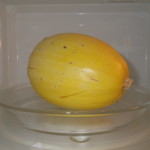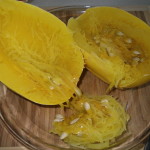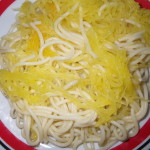A couple articles ago I wrote about no carb noodles https://news.nutritioneducationstore.com/shirataki/. It seems that people are always looking for something new or different to satisfy that pasta craving or provide a low calorie “vehicle” to carry a sauce. Here is a not-so-new option: spaghetti squash. 
If you have never had a spaghetti squash, you’re in for a treat. It is a vegetable, so also a great way to get more of those suggested vegetable servings. I remember when you could buy them “by the piece” and maybe I’ll see this later in the year when local squash is available, but now I can only find them sold “by the pound” and that price can add up quickly.
Spaghetti squash is a winter squash and will keep for several months if stored in a cool dry place. They won’t keep as long if you store them at room temperature. According to the USDA Nutrient Database, 1 cup contains 42 calories and 2 grams of fiber. Spaghetti squash is a good source of vitamin C, manganese and vitamin B6. Although it is yellow/orange in color, unlike other winter squash, one cup only contains 3% recommended daily value of Vitamin A.
For those who have never cooked a spaghetti squash before–don’t worry, it is easy. They can be baked, boiled or microwaved. I find the hardest part is getting through the outside skin to cut the raw squash. So I eliminate that step by cooking it whole in the microwave.
First I wash the outside of the squash. Then I puncture it with a knife (similar to what you do when baking a potato in the microwave—this allows for steam to escape so you don’t have “exploded” squash parts to clean up inside the microwave). Place the squash on a dish uncovered and microwave for 10-15 minutes depending upon the size. The squash shown in the photo is two pounds and it took 12 minutes. You can turn it over half-way through cooking. It should be soft to the touch. Cut it lengthwise and carefully remove the pulp and seeds. Then with a fork pull the spaghetti-like strands of squash out and fluff them. I got 4-5 cups of edible flesh from my two pound squash. 
A couple words of caution: be careful when cutting the cooked squash, it is very hot. Removing the seeds is easy, but it’s also easy to get too much of the pulp or too little of the seeds. I opt to error on leaving a few seeds in—they are edible.
As its name implies, the “strands” of squash resembles spaghetti and it can be substituted for pasta in many recipes. I sometimes combine it with regular pasta to “extend” the serving size and giving me the best of both worlds. But, it’s sweet and flavorful on its own— why not eat it as a wonderful vegetable?

Cheryle Jones Syracuse, MS
Professor Emeritus, The Ohio State University